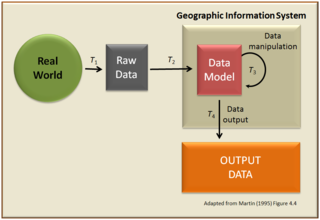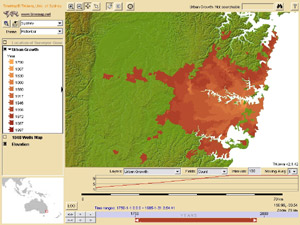Related Research Articles

A geographic information system (GIS) consists of integrated computer hardware and software that store, manage, analyze, edit, output, and visualize geographic data. Much of this often happens within a spatial database, however, this is not essential to meet the definition of a GIS. In a broader sense, one may consider such a system also to include human users and support staff, procedures and workflows, the body of knowledge of relevant concepts and methods, and institutional organizations.
GeoTIFF is a public domain metadata standard which allows georeferencing information to be embedded within a TIFF file. The potential additional information includes map projection, coordinate systems, ellipsoids, datums, and everything else necessary to establish the exact spatial reference for the file. The GeoTIFF format is fully compliant with TIFF 6.0, so software incapable of reading and interpreting the specialized metadata will still be able to open a GeoTIFF format file.
A GIS software program is a computer program to support the use of a geographic information system, providing the ability to create, store, manage, query, analyze, and visualize geographic data, that is, data representing phenomena for which location is important. The GIS software industry encompasses a broad range of commercial and open-source products that provide some or all of these capabilities within various information technology architectures.

QGIS is a free and open-source cross-platform desktop geographic information system (GIS) application that supports viewing, editing, printing, and analysis of geospatial data.
The Open Source Geospatial Foundation (OSGeo), is a non-profit non-governmental organization whose mission is to support and promote the collaborative development of open geospatial technologies and data. The foundation was formed in February 2006 to provide financial, organizational and legal support to the broader Free and open-source geospatial community. It also serves as an independent legal entity to which community members can contribute code, funding and other resources.
The concept of a Geospatial Web may have first been introduced by Dr. Charles Herring in his US DoD paper, An Architecture of Cyberspace: Spatialization of the Internet, 1994, U.S. Army Construction Engineering Research Laboratory.
GeoPDF refers to map and imagery products created by TerraGo software applications. GeoPDF products use geospatial PDF as a container for maps, imagery, and other data used to deliver an enhanced user experience in TerraGo applications. However, GeoPDF products conform to published specifications including both the OGC best practice for PDF georegistration as well as Adobe's proposed geospatial extensions to ISO 32000, making them readable by applications such as Adobe Acrobat, Adobe Reader, Avenza PDF Maps, Global Mapper, and others. GeoPDF products often include other advanced PDF features such as layers and object data which can add significant GIS functionality to the file, particularly when used with the TerraGo Technologies plugin to Adobe Reader or other TerraGo clients.
Geospatial metadata is a type of metadata applicable to geographic data and information. Such objects may be stored in a geographic information system (GIS) or may simply be documents, data-sets, images or other objects, services, or related items that exist in some other native environment but whose features may be appropriate to describe in a (geographic) metadata catalog.

Web mapping or an online mapping is the process of using maps, usually created through geographic information systems (GIS) on the Internet, more specifically in the World Wide Web. A web map or an online map is both served and consumed, thus, web mapping is more than just web cartography, it is a service where consumers may choose what the map will show.
The GeoNetwork opensource (GNOS) project is a free and open source (FOSS) cataloging application for spatially referenced resources. It is a catalog of location-oriented information.
A Spatial Data Infrastructure (SDI), also called geospatial data infrastructure, is a data infrastructure implementing a framework of geographic data, metadata, users and tools that are interactively connected in order to use spatial data in an efficient and flexible way. Another definition is "the technology, policies, standards, human resources, and related activities necessary to acquire, process, distribute, use, maintain, and preserve spatial data".
A geoportal is a type of web portal used to find and access geographic information and associated geographic services via the Internet. Geoportals are important for effective use of geographic information systems (GIS) and a key element of a spatial data infrastructure (SDI).
The Arizona Geographic Information Council (AGIC) was established by executive order as Arizona's primary forum and oversight group for coordination efforts related to geographic information systems (GIS). AGIC identifies standards and implementation strategies to provide a framework for optimizing Arizona's investment in GIS. Through cooperation and partnerships, AGIC facilitates the acquisition, exchange and management of geospatial data and technology to benefit State agencies and the Arizona GIS community. AGIC meets on a regular basis and conducts an Annual GIS Conference to address statewide GIS issues, requirements and solutions.
The Barrow Area Information Database (BAID) is designed to support Arctic science with a special focus on the research hubs of Barrow, Atqasuk, and Ivotuk on the North Slope of Alaska.
Bhuvan is an Indian web based utility which allows users to explore a set of map based content prepared by Indian Space Research Organisation. The content which the utility serves is mostly restricted to Indian boundaries and is offered in 4 regional languages. The content includes thematic maps related to disasters, agriculture, water resources, land cover and also processed satellite data of ISRO. Bhuvan is known for its association with various sections of Government of India to enable the use of Geospatial technology. Bhuvan has since its inception enabled Indian government to host public geospatial data as Information layers for visualisation and public consumption. Examples of the types of geospatial layers include Toll Information System for National Highways Authority of India, Islands information System for MHA, Cultural heritage sites for Ministry of culture etc. The information for the platform is obtained from the government of India sources or through Crowdsourcing.
The National Wetlands Inventory (NWI) was established by the United States Fish and Wildlife Service (FWS) to conduct a nationwide inventory of U.S. wetlands to provide biologists and others with information on the distribution and type of wetlands to aid in conservation efforts. To do this, the NWI developed a wetland classification system that is now the official FWS wetland classification system and the Federal standard for wetland classification. The NWI also developed techniques for mapping and recording the inventory findings. The NWI relies on trained image analysts to identify and classify wetlands and deepwater habitats from aerial imagery. NWI started mapping wetlands at a small scale. Eventually, large-scale maps became the standard product delivered by NWI. As computerized mapping and geospatial technology evolved, NWI discontinued production of paper maps in favor of distributing data via online "mapping tools" where information can be viewed and downloaded. Today, FWS serves its data via an on-line data discovery "Wetlands Mapper". GIS users can access wetlands data through an online wetland mapping service or download data for various applications. The techniques used by NWI have recently been adopted by the Federal Geographic Data Committee as the federal wetland mapping standard. This standard applies to all federal grants involving wetland mapping to insure the data can be added to the Wetlands Layer of the National Spatial Data Infrastructure. NWI also produces national wetlands status and trends reports required by the United States Congress.

TimeMap Java is an open-source web mapping application, which was one of the first such applications to introduce generic time filtering and map animation on the web. TMJava is a comprehensive Java mapping applet which can run as a standalone application with local data, on a web site or as a two tier application with a backend server and independent metadata clearinghouse, supporting distributed data sources.
The Wind Energy Data and Information (WENDI) Gateway was established by the Environmental Sciences Division of Oak Ridge National Laboratory in March 2010 to support the United States Department of Energy's Wind and Hydropower Technologies Program. It provided a digital library for wind energy-related data and information from a wide spectrum of sources—including data centers, scientific and technical journals, and geographic information systems (GIS), as well as the websites of government agencies, corporations and trade organizations. The gateway was taken offline after funding ended in August 2012. Much of its content was incorporated into the OpenEI site.
Geographic information systems (GIS) play a constantly evolving role in geospatial intelligence (GEOINT) and United States national security. These technologies allow a user to efficiently manage, analyze, and produce geospatial data, to combine GEOINT with other forms of intelligence collection, and to perform highly developed analysis and visual production of geospatial data. Therefore, GIS produces up-to-date and more reliable GEOINT to reduce uncertainty for a decisionmaker. Since GIS programs are Web-enabled, a user can constantly work with a decision maker to solve their GEOINT and national security related problems from anywhere in the world. There are many types of GIS software used in GEOINT and national security, such as Google Earth, ERDAS IMAGINE, GeoNetwork opensource, and Esri ArcGIS.
GeoSUR is a regional initiative led by spatial data producers in Latin America and the Caribbean to implement a regional geospatial network and to help establish the basis of a spatial data infrastructure in the region. GeoSUR supports the development of free access geographic services useful to find, view and analyze spatial information through maps, satellite images, and geographic data.
References
- 1 2 3 4 5 stories, A. summary of top; You, The Latest Geospatial Trends Emailed Direct to. "The Road Taken: The Evolution of GIS Data Clearinghouses From FTP to Map Services". www.directionsmag.com.
- ↑ "Information Technology". Archived from the original on 2015-01-22. Retrieved 2015-01-22.
- ↑ "Institute of Energy and the Environment". Institute of Energy and the Environment.
- ↑ "Pennsylvania Spatial Data Access". www.pasda.psu.edu.
- 1 2 3 4 5 6 "Archived copy" (PDF). Archived from the original (PDF) on 2015-09-24. Retrieved 2015-01-22.
{{cite web}}: CS1 maint: archived copy as title (link) - ↑ Kelly, M.C., Baxter, R.E., & Haupt, B.J. (2008). The evolution of spatial data infrastructure (SDI) geospatial data clearinghouses: Architecture and services. In Encyclopedia of Data Warehousing and Mining, (2nd ed.). Hershey, Pennsylvania: Idea Group, Inc.
- ↑ Nebert, D. (Ed.) (2004). Developing spatial data infrastructures: The SDI cookbook (v.2). Global Spatial Data Infrastructure Association. http://www.gsdi.org.
- 1 2 Kelly, M.C. & Stauffer, B.E. (2000). User needs and operations requirements for the Pennsylvania Geospatial Data Clearinghouse. University Park, PA: The Pennsylvania State University, Environmental Resources Research Institute.
- 1 2 3 Kelly, M.C., Haupt, B.J., & Baxter, R.E. (2009). Internet map services and Web GIS: The new paradigm in spatial and temporal data integration over the Web. In Encyclopedia of Database Technologies and Applications, (2nd ed.). Hershey, Pennsylvania: Idea Group, Inc.
- 1 2 "Archived copy". Archived from the original on 2015-01-22. Retrieved 2015-01-22.
{{cite web}}: CS1 maint: archived copy as title (link) - ↑ "Pennsylvania Atlas". maps.psiee.psu.edu.
- ↑ "Pennsylvania Imagery Navigator and Download Tool". maps.psiee.psu.edu.
- 1 2 "Pennsylvania Mine Map Atlas". www.minemaps.psu.edu.
- 1 2 3 "Penn State, DEP collaborate on digital Pennsylvania Mine Map Atlas - Penn State University". news.psu.edu.
- ↑ "Pennsylvania Launches Online Mine Map Viewer | Business Journal Daily". Archived from the original on 2015-01-22. Retrieved 2015-01-22.
- 1 2 "About PASDA - What is PASDA". Archived from the original on 2013-01-08. Retrieved 2015-01-22.
- ↑ Open data